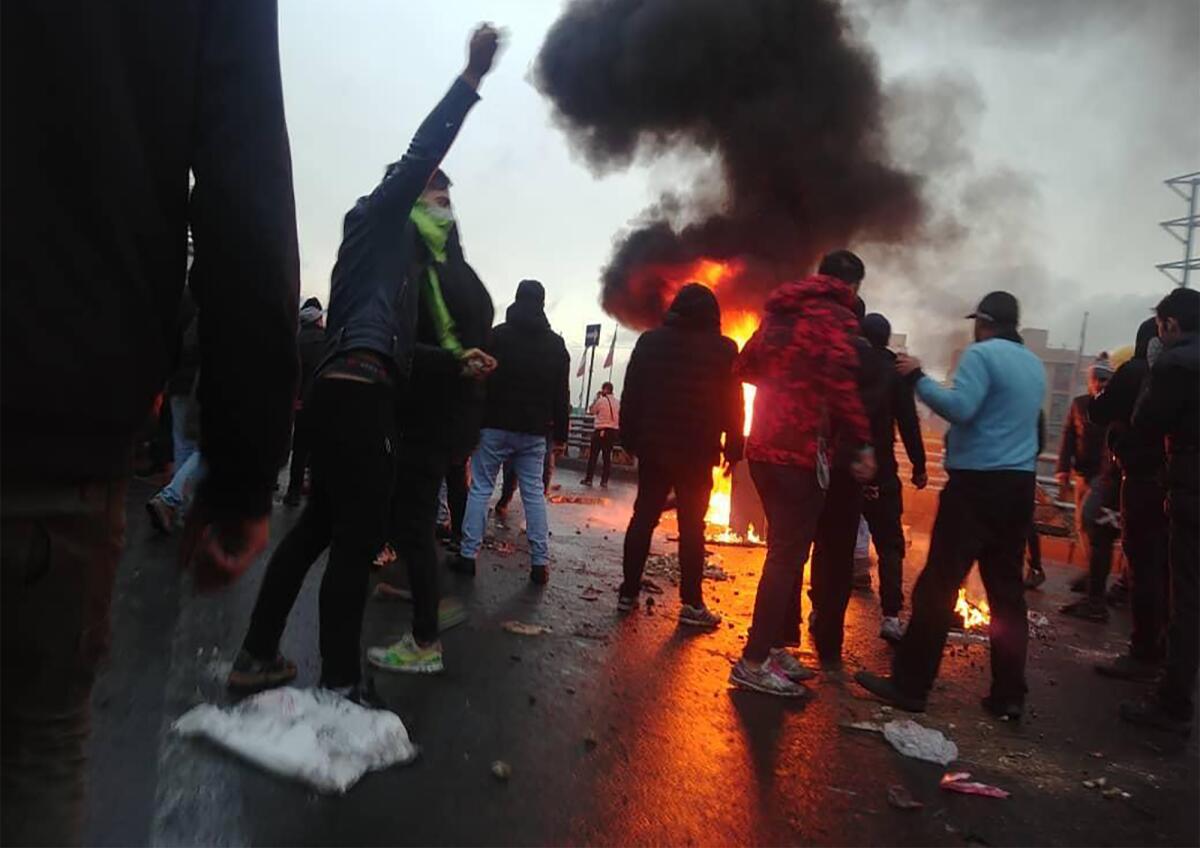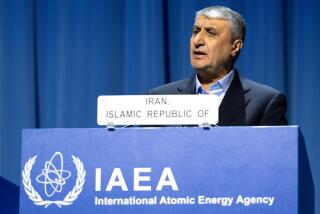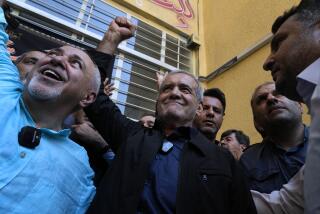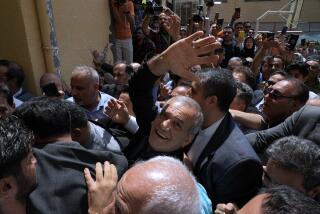What’s driving Iran’s crackdown on protesters? Increased unity among the political establishment

- Share via
Tehran — When tens of thousands of Iranians nationwide began taking to the streets more than a week ago to protest gasoline price hikes of as much as 50%, security forces quickly clamped down.
Across Iran, more than 100 demonstrators have been killed, dozens of others injured and thousands arrested, according to international human rights activists.
Analysts say the brutal government reaction reflects growing unity among the country’s political elites, signaling that President Hassan Rouhani’s government — once labeled as relatively moderate — has shifted significantly to the right and is increasingly aligning with the country’s hard-line Islamic religious leaders.
The shift, experts say, is a sign that Iranian moderates and reformers have increasingly lost influence following President Trump’s withdrawal last year from the landmark multinational 2015 nuclear accord with Iran and his subsequent reimposition of tough economic sanctions.
“Iran relies on security forces and needs internal cohesion, especially when they feel an external threat, which they did after the nuclear deal was thrown out by Trump,” said Reza H. Akbari, program manager at the Washington-based Institute for War and Peace Reporting.
When protests erupted in Iran two years ago over economic woes, authorities demonstrated restraint before eventually cracking down.
“There appeared to be a bigger gap between Iran’s executive, judiciary and legislative branches on how to handle the protests in 2017, but it appears those gaps on how to handle the protests don’t exist anymore or are very minor,” Akbari said.
The more violent reaction in recent days “could indicate a level of cohesion among the decision makers,” he said.
Experts say Rouhani’s reaction is politically expedient because it makes it more difficult for hard-liners to further sideline and isolate his administration.
“Rouhani has lost so much political capital after Trump withdrew from the nuclear deal,” said Ariane Tabatabai, an associate political scientist at Rand Corp. “In the space of one week the protests escalated really quickly ... the government has been quicker and a lot more effective in unleashing security forces and making a bunch of arrests.”
Iranian authorities blocked nearly all internet access soon after demonstrations began Nov. 15, a move that has made it difficult to get a clear reading on the number of people who have died or were injured or arrested.
According to the New York-based nonprofit Center for Human Rights in Iran, more than 2,700 people have been arrested. Amnesty International said that at least 106 protesters were killed in clashes with security forces in several cities across Iran. Videos circulating on social media also indicate violent suppression of peaceful protesters.
In Tehran, the mood has been tense and people who participated in the protests remain worried they will be detained by police in coming days. Some injured in the protests have been hesitant to seek help at hospitals for fear of arrest.
Most hard-hit have been rural provinces and lower-income neighborhoods in Kermanshah, Fars and Khuzestan — similar to where protests erupted two years ago.
On Wednesday, Rouhani addressed the protests by calling those who took to the streets “a small group of enemy soldiers.” When protests ignited two years ago, Rouhani, in a televised address, recognized the right of people to demonstrate on the streets.
“People are allowed under the constitution to criticize or even protest but … in a way that at the end they lead to a better situation in the country for the people,” he said at the time.
Another indication of political retrenchment is the decision to increase the price of fuel, which was the result of a meeting between the heads of Iran’s three branches of government.
“They all agreed before the policy was rolled out,” Akbari said.
For years, Iranians have struggled to make ends meet because of an economy stunted by high unemployment and rising prices on food and medicine. The increase on fuel prices, triggered in part by a reduction in government gasoline subsidies, proved a tipping point for many protesters.
Authorities said the price increase would help provide additional government assistance for 60 million eligible Iranians, including many in rural areas, as well as teachers, laborers, public employees, aid workers, social workers and women head of households. The Islamic Republic reportedly started the subsidy payment handouts on Monday.
Rouhani, who was first elected in 2013 with nearly 51% of the vote, had been considered a moderate, promising to bring more social freedoms to the Islamic Republic. On several occasions he had openly criticized hard-liners, including Iran’s powerful Revolutionary Guard.
But this appears to be a turning point in upcoming February parliamentary elections.
“People may not see the incentive in coming out to vote. Of course, the system has never been free and fair but there has always been a relative contrast between the candidates that do qualify. Rouhani’s shift to the right will increase the political price for reformist candidates,” Akbari said.
Reformists are those who seek closer ties with the West and want more freedom and diversity of thought in Iran’s political system. Historically, in elections with a low turnout, conservative candidates have come out victorious.
“Reformists are the ultimate losers, left alone to fend for themselves,” Akbari said. “Conditions were already bad for the reformists but they are especially dire now.”
Staff writer Etehad reported from Los Angeles and special correspondent Mostaghim from Tehran.
More to Read
Sign up for Essential California
The most important California stories and recommendations in your inbox every morning.
You may occasionally receive promotional content from the Los Angeles Times.











